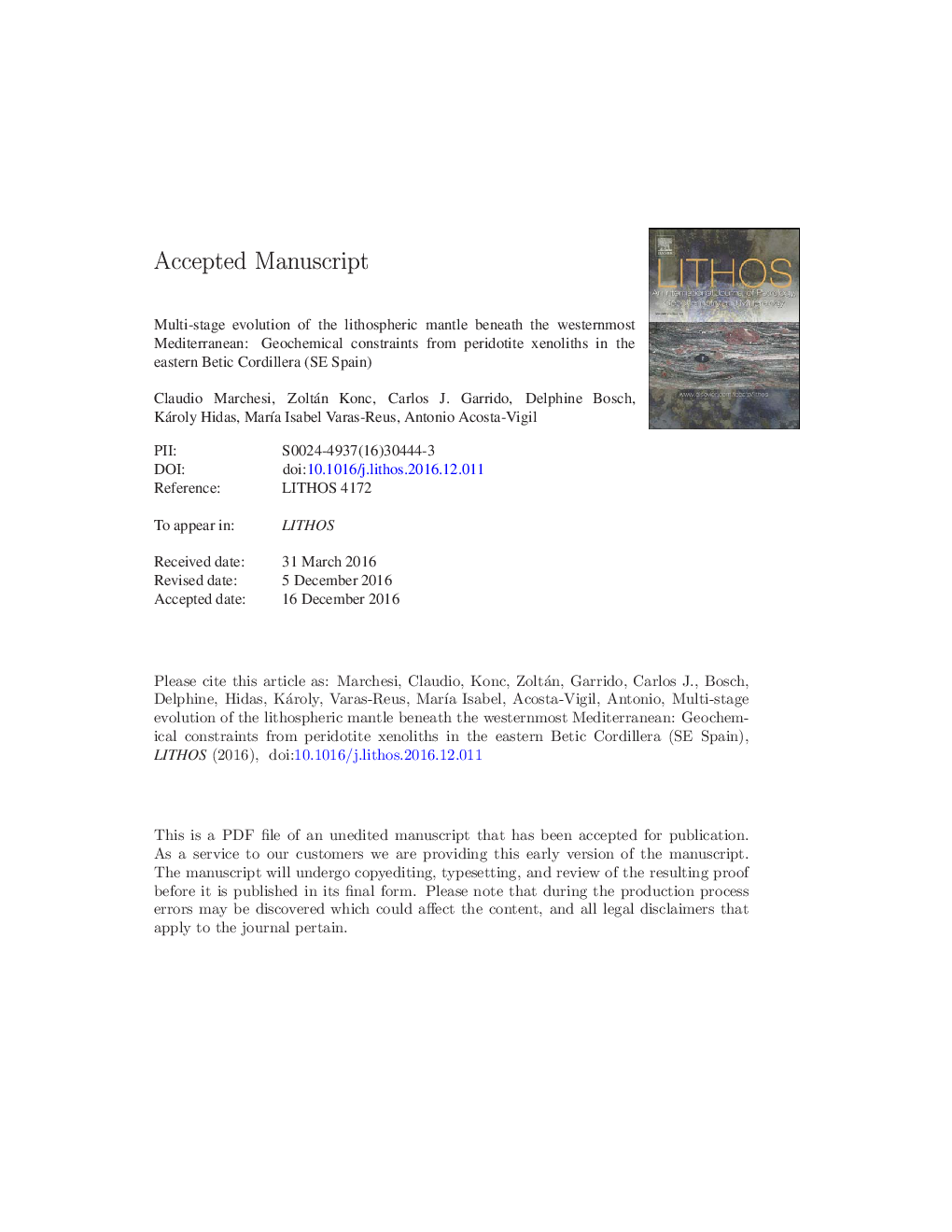| کد مقاله | کد نشریه | سال انتشار | مقاله انگلیسی | نسخه تمام متن |
|---|---|---|---|---|
| 5784109 | 1638634 | 2017 | 55 صفحه PDF | دانلود رایگان |
عنوان انگلیسی مقاله ISI
Multi-stage evolution of the lithospheric mantle beneath the westernmost Mediterranean: Geochemical constraints from peridotite xenoliths in the eastern Betic Cordillera (SE Spain)
دانلود مقاله + سفارش ترجمه
دانلود مقاله ISI انگلیسی
رایگان برای ایرانیان
موضوعات مرتبط
مهندسی و علوم پایه
علوم زمین و سیارات
ژئوشیمی و پترولوژی
پیش نمایش صفحه اول مقاله

چکیده انگلیسی
Spinel (± plagioclase) peridotite xenoliths from the Tallante and Los Perez volcanic centres in the eastern Betics (SE Spain) range from depleted (clinopyroxene-poor) harzburgites to fertile (clinopyroxene-rich) lherzolites and orthopyroxene-free wehrlites. Significantly, only one harzburgite, which is depleted in heavy rare earth elements (HREE), retains the imprint of ca. 20% ancient melting of an original garnet lherzolite source. In contrast, REE abundances of other harzburgites and lherzolites from the eastern Betics have been increased by melt-rock reaction. The whole-rock and mineral compositions of these mantle rocks are largely controlled by three types of modal metasomatism: 1) common clinopyroxene-orthopyroxene addition and olivine consumption which increased FeOt, SiO2 and Al2O3, and decreased MgO compared to the refractory melting products; 2) subordinate orthopyroxene dissolution and precipitation of clinopyroxene and olivine, which led to higher FeOt and MgO and lower SiO2 than in common (orthopyroxene-rich) lherzolites; and 3) rare orthopyroxene consumption and olivine addition that caused higher FeOt and lower SiO2 compared to the original melting residues. These mineral modal and major element variations have been produced mostly by interactions with relatively FeOt-rich/SiO2-poor melts, likely derived from a peridotite-pyroxenite lithospheric mantle with a highly heterogeneous isotopic composition. Melting of the lithospheric mantle in the western Mediterranean was triggered by upwelling of the asthenosphere induced by back-arc extension in the Late Oligocene-Early Miocene. Trapping of small fractions of exotic melts in whole-rocks - likely the parental magmas of Miocene back-arc dykes that intruded the Betic crust - caused local disequilibrium between the trace element signatures and Pb isotopic compositions of clinopyroxene and whole-rock. Subsequent interaction with SiO2-undersaturated magmas, similar to the parental melts of the Pliocene alkali basalts that host the xenoliths, promoted orthopyroxene consumption and clinopyroxene-olivine enrichment at locations close to magma conduits, and finally generated orthopyroxene-free wehrlites. This event constitutes the last episode of the Cenozoic magmatic evolution of the westernmost Mediterranean which is recorded in the mantle xenoliths from the eastern Betics.
ناشر
Database: Elsevier - ScienceDirect (ساینس دایرکت)
Journal: Lithos - Volume 276, 1 April 2017, Pages 75-89
Journal: Lithos - Volume 276, 1 April 2017, Pages 75-89
نویسندگان
Claudio Marchesi, Zoltán Konc, Carlos J. Garrido, Delphine Bosch, Károly Hidas, MarÃa Isabel Varas-Reus, Antonio Acosta-Vigil,